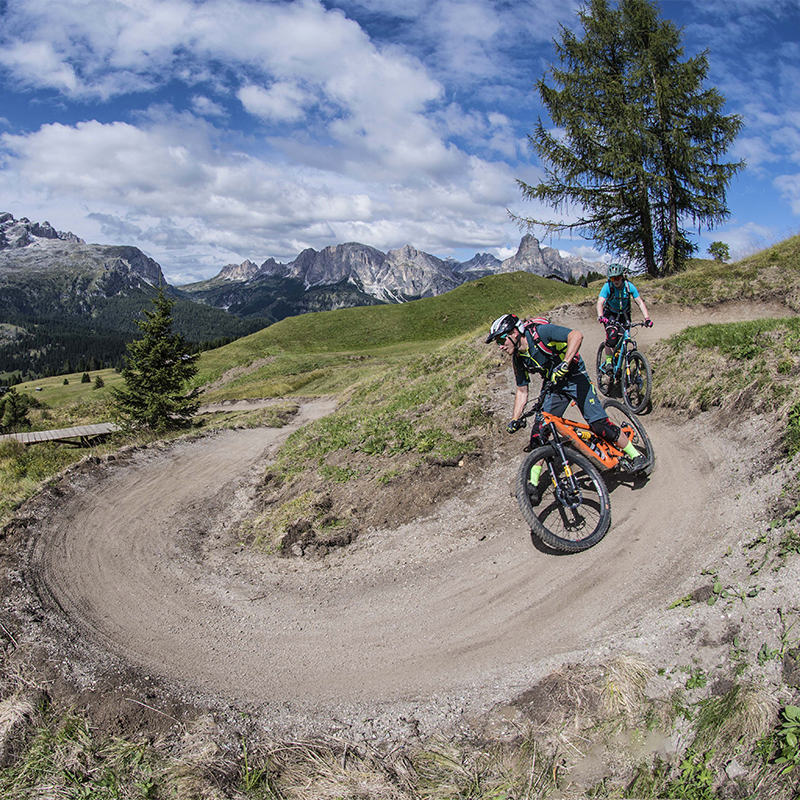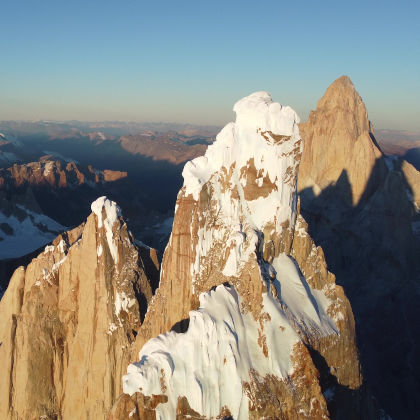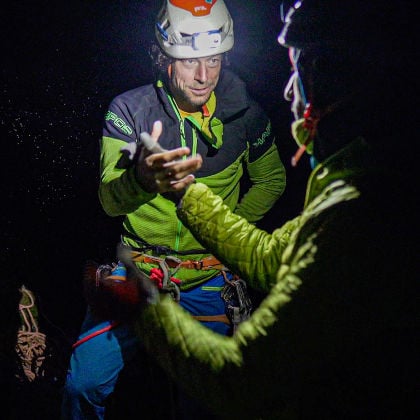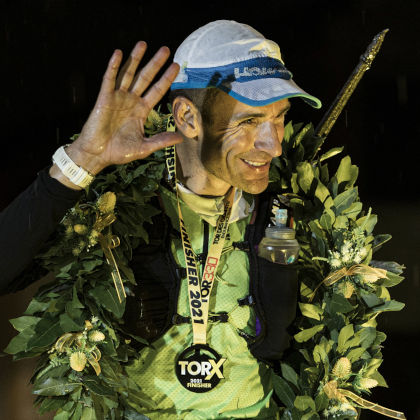
JUNGFRAU: DISCOVERING THE RICH VOID
From glaciers to peaks with skis and skins
by Umberto Isman
A passionate mountaineer, ski mountaineer, hiker, and cyclist, Umberto Isman spends his free time chasing dreams that come to life at high altitude. An expert photographer, with his lens he’s able to capture the most intimate moments in the relationship between man and mountains. A contributor to numerous specialty publications, he tells about the mountains in images and words, experiencing them firsthand.
An Italo-Swiss former cycling champion, a mountain guide and ski mountaineer from Valle d’Aosta, and a talented young Swiss mountaineer from the Bernese Oberland decide, with a videographer and a photographer, to go to the longest glacier of the Alps: the Aletsch Glacier.
But let’s get away from the joke setup and provide the names. In order: Andrea Peron, Denis Trento, Nadine Grossnicklaus, Ruggero Arena, and Umberto Isman.
The easiest way to reach the Aletsch Glacier is to take the Jungfrau train, which since 1912 has taken passengers to the highest railway station in Europe, at the Jungfraujoch, 3,454 meters above sea level. The train also reveals a cross section of humanity, representing different nationalities and travel purposes. The fact is that with your ski mountaineering boots you have to be careful not to step on the flip-flops of some Indian tourists on a pilgrimage to the locations featured in several Bollywood films. And you might find an Asian boy who puts a snowball in his pocket to take to his cousin. Then the exit from the station is a mixture of sensations, from the aromas of the Indian restaurant to the multimedia installations — almost a last barrage of civilization before you emerge into the void of glaciers and peaks. And it’s there that the diverse humanity gradually reenters its ranks, along a road traced in the snow that soon discourages the flip-flops, rewards the hiking boots, and finally launches the satisfied ski mountaineers toward their habitat.
IN THE KINGDOM OF SKINS
We, the group from the joke, decide to immediately aim for the southwest ridge of Mönch, one of the few four-thousanders that can be reached in a day from the cities in the flatlands. With a quick change of gear, we put on our harnesses and choose from among our ample selection the most suitable garments for the conditions and for the photos and videos. The work of the photographer (myself) and the videographer (Ruggero) in these situations involves the continuous consideration of data and parameters concerning safety above all, then the possibility of moving both together with the athletes and on routes that allow us to capture good images, and finally the thousands of technical and composition-related variables of the images themselves.
Knowledge and memory of the locations is also needed; in this case, for me it’s a historical memory, since I began coming to the area in the mid-80s, and my last time on this crest of the Mönch was 11 years ago, to be precise. I hardly recognize it. The glacier at the base of the ridge is considerably lower, and a steep rocky stretch at the beginning makes it more challenging. In reality, the advancing age of those coming to the glaciers also amplifies the perception of their objective worsening. I’ll have to come to terms with that. We continue to climb roped up, until the ridge becomes a thin thread between two cantons: Valais and the Bernese Oberland. Better not cross over. From the top we turn around and descend, but not before Ruggero, in a precarious position, also manages to fly his drone. At the base of the ridge, we recover the gear we had left behind, protecting it from possible assault by Alpine choughs, which even at these altitudes often rob others’ food.

The mountain hut awaits us. It’s called Mönchsjochhütte, a kind of tongue twister for those who aren’t from here. It’s a modern structure, perched on and suspended from the rocks emerging from the glacier. Inside, the organization is Teutonic: precise and rational. The hours are set and that’s that, including breakfast time and therefore departure time in the morning.
Finally sitting around a table, between one dish and the next, we begin to get to know each other. I already know Andrea, I met Denis once, and the other two are a pleasant discovery. We seem like a close-knit team already, but those are the dynamics and we know them well. However, we learn that the planned ascent to the Jungfrau is not feasible. In an ironic twist of fate, in a winter so lacking in precipitation, it has snowed heavily in recent days, and making tracks on the steep slopes of the “Maiden” is still too dangerous. We therefore decide to settle for a lower peak, at an elevation of 3,658 meters, south of the Jungfrau, the Louwitor (I discover its name now on the map), from which we can descend to the other side.
My last time on this crest of the Mönch was 11 years ago, to be precise. I hardly recognize it. The glacier at the base of the ridge is considerably lower, and a steep rocky stretch at the beginning makes it more challenging. In reality, the advancing age of those coming to the glaciers also amplifies the perception of their objective worsening. I’ll have to come to terms with that.
So the next morning we leave the hut just before sunrise and let our skis run downhill along the gentle slopes of the Jungfraufirn. In reality, we are exactly at the head of the Aletsch Glacier, which from here extends as far as the eye can see, for more than 20 kilometers, toward the southeast, with a maximum ice thickness of about 900 meters, which still bodes well for its survival. Denis, drawing on his extensive experience, leads the party. Not that there are any particular difficulties, but we are still on a massive glacier, and it’s better to proceed roped up. We go around a series of large seracs and deep crevasses, perfect backdrops for photos. The pace is certainly not what
Denis would impose if he could. His victories in the Mezzalama, the Pierra Menta, and the ski mountaineering world championships, his great performances at high altitude, his extreme descents, have little connection to what we’re doing, but it’s his first time in these mountains and we recognize that his eyes and his brain observe in a different way from ours, projected more into a hypothetical future than in the “meager” present.
Nadine, in contrast, despite her little more than 20 years of age, is the host welcoming us to her mountains. She explains to us the entire orography of the territory and tells us about the almost infinite possibilities for ski mountaineering. She confirms that she has to go back to work, so, after the descent, she’ll bid us farewell, climb back up the glacier, and throw herself down the Lötschental, which, with its 2,000 meters of elevation loss, will take her to the bus and then to the train home. More or less like when I go to Milan by public transport. And that’s what happens: we descend to the Aletschfirn and tell her goodbye, and ask that she at least send us a message when she gets home.
THE LAST DESCENT
With four of us left, we split up further: Denis and Andrea, never daunted, decide to go to Konkordiaplatz, continue toward the Grünhornlücke, and return to the Konkordia hut, while Ruggero and I are satisfied with the basic plan that includes climbing to the hut directly from Konkordiaplatz.
Konkordiaplatz is a glacial version of a real city square, much larger than the Parisian one whose name it mimics. It’s an immense white plain at the confluence of five glaciers, where, it’s said, a jumbo jet could land. At the eastern end of the plain rise the rocky spurs on which the Konkordiahütte is placed, the hut that over the years moves higher and higher. Of course, it’s the glacial plain below that’s sinking, but the fact is that the difference in height continues to increase. Since the last time I was here, the metal staircase to the hut has been replaced with a much higher and more direct structure. We meet people who are forced to clip in due to dizziness.
We finally reach the hut. It’s full and we are assigned to the winter quarters. Better this way — we’re out of the crowds and we even have a little room to ourselves. Even if we have to deal with the most treacherous stretch of the entire crossing, the short icy path that connects our annex with the main building, wearing our Crocs. The sun is out, which is helpful for climbing skins, shoes, sweaty shirts. A potentially lethal mixture of odors that disperses without a trace in the thin air. We immerse ourselves in the life of the hut, which is always the same, made up more of time to pass than time that passes. Almost a waiting room, filled only with small things and basic needs, dinner above all. And photos, always, of the immensity of the landscape, of the people, of the details of this Alpine microcosm so populated and so far from everything else.
It is precisely the immensity that puts us to the test the following morning. Having returned to the glacier early, careful not to slide off the stairs, we recross Konkordiaplatz and move onto the wide and almost flat Grosser Aletschfirn again. A long journey awaits us, with always the same steps and a precise direction, toward the Lötschenlücke. We realize once again that this is one of the few Alpine places where those who’ve experienced the Himalayas relive many of the same feelings: the grandeur, the expanded distances, the never reaching your destination, the dots in the distance that remain dots for hours. The glaciers of the Jungfrau-Aletsch region are small-scale models of the frozen Baltoro belt, or the great Khumbu glaciers.
It’s like this also for the last descent into the Lötschental — infinite, a sort of slow decompression, a gradual return to civilization, until Denis’s final observation: “Nice, but next time more elevation gain, fewer kilometers, and a bit steeper gradient.”
experience by





